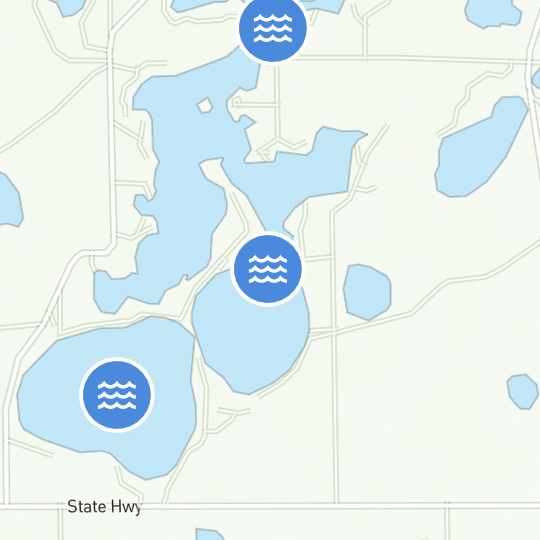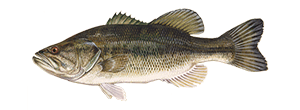Best Fishing Knots
Learn how to choose and tie the best knot for fishing with hooks, lures and rigs. Note that there may be more than one “best fishing knot” for the various item of tackle used.
The knots presented below have been tested and proven to offer at least 90 percent of the original line strength when tying tackle (lures, swivels, sinkers, bobbers, etc.) to a line. While most beginning anglers choose the easiest option when learning how to tie fishing knots, don’t be afraid to try more complicated knots as you advance. Not only can learning fishing knot techniques that are more complex be challenging and rewarding, you may also find that it makes certain goals easier to achieve. Start with some of these basic best fishing knots that allow you to simply enjoy your hobby.
1. Improved Clinch Knot
Many anglers consider the improved clinch knot to be the best knot for fishing with lures. Not only is this knot versatile enough for securing your line to a lure, swivel, clip, or artificial fly, it retains up to 95% of the original line strength. The key to tying this popular best fishing knot for lures is to make five turns of the tag end around the standing end before running the tag end back through the formed loop.
- Thread the line through the eye of the hook or lure leaving about 6-12 inches of line.
- Leaving a small space between the line and the hook eye, twist the tag end around the standing line five times.
- Pass the tag end back through the small space you made near the hook eye.
- Then run the tag end back through the second loop you created in step 3.
- Pull both the standing line and the tag end slowly away from hook.
- Moisten your lines with saliva or water.
- Pull only the standing line firmly away from the hook.
2. Uni Knot or Duncan Knot
Some consider the uni knot to be the best fishing knot for tying an eyed hook to a leader. Don't be afraid to cut the end short with this knot. It'll hold. These fishing knots are great to learn because they work well with braided or monofilament fishing line and can be used to tie lines of unequal diameter together.
- Pass the line through the eye of the hook and double back parallel to the standing line.
- Make a loop by laying the tag end over the doubled line, while both lines face the same direction.
- Next, make five or six turns with the tag end around the doubled line and through the loop.
- Holding your swivel or hook in one hand and both ends of the line in the other hand, pull them apart gently so the knot is almost tied, but not yet tight.
- Moisten the lines with some saliva and pull only the standing line firmly away from your hook or swivel.
- Lastly, trim the tag end to complete your knot.
3. Non-Slip Loop Fishing Knots
Non-slip loop knots create a fixed loop so a hook can move freely. It is best with larger lines where a tight knot, such as the improved clinch can impede hook, bait or lure movement.
- Tie an overhand knot about 10 inches from the end of the line. Pass the tag end through the lure eye and then back through the overhand loop.
- Above the overhand, wrap the tag end around the standing line five times.
- Then pass it back through the overhand knot once more.
- Moisten the lines with saliva then pull tight.
4. Snelling An Eyed Hook
Snelling means tying the knot away from the eye of the hook. These fishing knots work well for any type of fishing to increase strength and improve catch rates with bigger fish.
- Start with an up-turned or down turned eye hook. Pass the line through the hook and form a large loop along the shank of the hook. The tag end should lay along the shank of the hook.
- Turn the entire loop around the shank of the hook and the tag end, forming wraps down the shank towards the curve of the hook. Depending on the size of the hook and the size of the line, you might need 6-10 wraps.
- Pull on the main line to tighten the snell.
5. Spade-End Knot
A spade hook has no eye. Thus, it should come as no surprise that the recommended best knot for fishing with a spade hook is a spade-end knot. To rig, you will have to tie a knot next to the flat, bent end of the hook shank. Spade hooks are small, but don't worry; it will hold.
- Lay the line along the hook shank and cross the tag end over the standing end to form a small loop near the bend.
- Take the tag end and wrap it aroun the shank of the hook and the standing end at least 8 times.
- Take the tag end and pass it through the loop at the bottom of the hook and gently pull tight.
- Trim the tag end.
The spade end version relies on the same method as above, but you don’t have to pass the main line through the loop because there is no loop.
Now that you’ve learned how to tie some of these best fishing knots, you’re ready to build fishing rigs at the end of your line.
KEEP LEARNING

How to Tie the Non-Slip Loop Knot
The non-slip loop knot is a popular and reliable choice for securing hooks, lures, and other tackle to your fishing line.
LEARN MORE

Socials
Take me fishing social media links
LEARN MORE

TakeMeFishing x Teen Vogue
Join us on a creative journey as fashion designer Ahmrii Johnson walks us through her collaborative vision and process with Teen Vogue and fashion brand, Rentrayage, to create a special piece.
LEARN MORE


.png?lang=en-US&ext=.png)